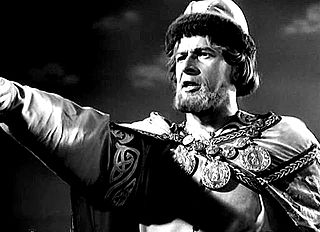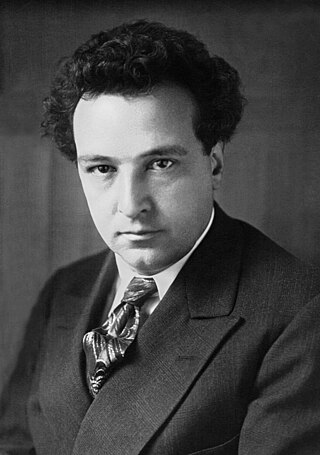External links
| Operas | |||||
|---|---|---|---|---|---|
| Ballets | |||||
| Symphonies | |||||
| Concertos |
| ||||
| Orchestral works | |||||
| Film music | |||||
| Vocal music | |||||
| Chamber music | |||||
| Piano music |
| ||||
| Related articles | |||||
Sergei Prokofiev's Symphonic Song (Russian : Симфоническая песнь), Op. 57, was written in 1933.
Symphonic Song is a work demonstrating Prokofiev's transition from Parisian modernism to Soviet lyricism. Prokofiev had described of it as "a serious piece of work, and I took great care in choosing the thematic material. It consists of three closely integrated parts."
Although there is no programme, the mood of the three parts might be defined as:
The work lasts around 13 minutes, and is in one continuous movement.
The music is scored for piccolo, 2 flutes, 2 oboes, English horn, 2 clarinets, bass clarinet, 2 bassoons, contrabassoon, 4 horns, 3 trumpets, 3 trombones, tuba, timpani, cymbals, triangle, bass drum, snare drum, tambourine, and strings.
14/04/1934, Moscow, conducted by Alexander Gauk.
| Orchestra | Conductor | Record Company | Year of Recording | Format |
|---|---|---|---|---|
| Scottish National Orchestra | Neeme Järvi | Chandos Records | 1989 | CD |
| USSR Ministry of Culture State Symphony Orchestra | Gennadi Rozhdestvensky | Melodiya | ? | LP |

The bass clarinet is a musical instrument of the clarinet family. Like the more common soprano B♭ clarinet, it is usually pitched in B♭, but it plays notes an octave below the soprano B♭ clarinet. Bass clarinets in other keys, notably C and A, also exist, but are very rare. Bass clarinets regularly perform in orchestras, wind ensembles and concert bands, and occasionally in marching bands, and play an occasional solo role in contemporary music and jazz in particular.
The Symphony No. 6 in B minor, Op. 54 by Dmitri Shostakovich was written in 1939, and first performed in Leningrad on November 5, 1939 by the Leningrad Philharmonic Orchestra under Yevgeny Mravinsky.

Sergei Prokofiev wrote his Symphony No. 2 in D minor, Op. 40, in Paris in 1924-25, during what he called "nine months of frenzied toil". He characterized this symphony as a work of "iron and steel".

Sergei Prokofiev wrote his Symphony No. 3 in C minor, Op. 44, in 1928.

Sergei Prokofiev's Symphony No. 4 is actually two works, both using material created for The Prodigal Son ballet. The first, Op. 47, was completed in 1930 and premiered that November; it lasts about 22 minutes. The second, Op. 112, is too different to be termed a "revision"; made in 1947, it is about 37 minutes long, differs stylistically from the earlier work, reflecting a new context, and differs formally as well in its grander instrumentation.
Russian Christmas Music is a musical piece for symphonic band, written by Alfred Reed in 1944. It is one of the most frequently performed pieces of concert band literature.
Armenian Dances is a musical piece for concert band, written by Alfred Reed (1921–2005). It is a four-movement suite of which Part I comprises the first movement and Part II comprises the remaining three. The two parts comprise a full-length symphony. Each part consists of a number of Armenian folk songs from the collection of Komitas Vardapet (1869–1935), an Armenian ethnomusicologist.
Catfish Row, originally titled Suite from Porgy and Bess, is an orchestral work by George Gershwin based upon music from his famous opera Porgy and Bess. Gershwin completed the work in 1936 and it premiered at the Academy of Music in Philadelphia on January 21 of that year, with Alexander Smallens conducting the Philadelphia Orchestra. Gershwin played the piano part, including the piano solo in the opening moments. This piece preserves some of the darkest and most complex music Gershwin ever wrote.
Porgy and Bess: A Symphonic Picture is a 1942 orchestral medley arranged by George Gershwin's good friend and sometimes assistant, Robert Russell Bennett, which includes most of the best-known songs from the Gershwin opera Porgy and Bess, although not in the exact order of their appearance. Though the Symphonic Picture is sometimes dismissed as a sequence of the opera's "greatest hits," the first well-known melody, "Summertime," is not heard until nearly seven minutes into the work. While some of the more esoteric parts of the opera are absent, many of the catchier tunes that can be heard in this suite are absent in others, including Gershwin's own Catfish Row Suite, which tended to highlight the more cerebral elements of the work.

Alexander Nevsky is the score composed by Sergei Prokofiev for Sergei Eisenstein's 1938 film Alexander Nevsky. The subject of the film is the 13th century incursion of the knights of the Livonian Order into the territory of the Novgorod Republic, their capture of the city of Pskov, the summoning of Prince Alexander Nevsky to the defense of Rus', and his subsequent victory over the crusaders in 1242. The majority of the score's song texts were written by the poet Vladimir Lugovskoy.
Ivan the Terrible, Op. 116, is the score composed by Sergei Prokofiev for Sergei Eisenstein's film Ivan the Terrible (1945) and its sequel (1958), the first two parts of an incomplete trilogy. The project was Prokofiev's second collaboration with Eisenstein, the first being the popular Alexander Nevsky (1938). The majority of the non-liturgical song texts were written by Vladimir Lugovskoy, who collaborated with Prokofiev on the texts for Alexander Nevsky.
Music for Prague 1968 is a programmatic work written by Czech-born composer Karel Husa for symphonic band and later transcribed for full orchestra, written shortly after the Soviet Union crushed the Prague Spring reform movement in Czechoslovakia in 1968. Karel Husa was sitting on the dock at his cottage in America at the time, listening to the BBC broadcast of the events on the radio. He was deeply moved, and wrote Music for Prague 1968 to memorialize the events. This piece is a standard among wind ensemble repertoire.
Zdravitsa, Op. 85, is a cantata written by Sergei Prokofiev in 1939 to celebrate Stalin's 60th birthday. Its title is sometimes translated as Hail to Stalin in English. A performance lasts around thirteen minutes.
Sergei Prokofiev wrote the symphonic suite The Year 1941 in 1941.

Serenada Schizophrana is a suite of six symphonic movements written by American film composer Danny Elfman in 2004. It was commissioned by the American Composers Orchestra, which premiered the work at Carnegie Hall in New York City on February 23, 2005, conducted by Stephen Sloane. A studio recording was released on October 3, 2006, with John Mauceri conducting the Hollywood Studio Symphony orchestra. Album art was done by George Condo.
Cello Concerto in E minor, Op. 58 is a concerto written by Sergey Prokofiev between 1933 and 1938. Its duration is approximately 35 minutes. It consists of three movements:

Le Roi David was composed in Mézières, Switzerland, in 1921 by Arthur Honegger, as incidental music for a play in French by René Morax. It was called a dramatic psalm, but has also been performed as oratorio, without staging. The plot, based on biblical narration, tells the story of King David, first a shepherd boy, his victories in battle, relationship to Saul, rise to power, adultery, mourning of his son's death, and finally his own death. The work has 27 musical movements consisting of voice solos, choruses, and instrumental interludes. A narrator unifies the work by providing spoken narration of the story of King David.

Lior Navok is an Israeli classical composer, conductor and pianist. He was born in Tel Aviv. Navok studied composition privately with the Israeli composer Moshe Zorman, and completed a Bachelor's degree at the Jerusalem Academy of Music and Dance, where he studied composition and conducting. He later completed he studied for a Master's and Doctorate at the New England Conservatory, where he studied with John Harbison.
Composed in 1957, Symphonic Songs for Band is one of Robert Russell Bennett's most famous compositions for wind band. The work was commissioned for the National Intercollegiate Band by Kappa Kappa Psi and Tau Beta Sigma, national honorary band fraternity and sorority, as part of the two organizations' commissioning program. Since its premiere, it has become among the most frequently performed works in the wind band repertoire. It is considered to be a cornerstone of the band literature.

The Queen of Spades, Op. 70, is the score composed by Sergei Prokofiev in 1936 for the planned but unrealized film by Mikhail Romm. The film was to be based on the 1834 short story "The Queen of Spades" by Alexander Pushkin, and was intended for release in 1937, the centenary of Pushkin's death. It is one of Prokofiev's least known pieces.